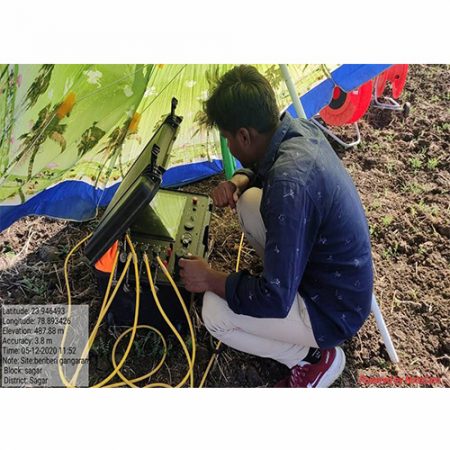We offer a non-destructive and cost-effective solution for surface imaging
Electrical Resistivity Tomography
Electrical resistivity tomography (ERT) is a non-destructive geophysical subsurface-imaging technique and is widely used in mineral prospecting, hydrological exploration, environmental investigation and civil engineering, as well as archaeological mapping. RAY SPEED collects ERT data rapidly with an automatic 120 multi-electrode resistivity meter. It is a very useful method characterising the sub-surface materials in terms of their electrical properties. Variations in electrical resistivity (or conductivity) typically correlate with variations in lithology, water saturation, fluid conductivity, porosity and permeability, which may be used to map stratigraphic units, geological structure, sinkholes, fractures and groundwater. The survey data is processed to produce graphic depth sections of the thickness and resistivity of subsurface electrical layers. The resistivity sections are correlated with ground interfaces such as soil and fill layers, aquifers or soil-bedrock, interfaces, to provide detailed information on subsurface natural resources and geological conditions. ERT is extremely useful for understanding the sub-surface formations and for depth estimations of natural resources. 2D and 3D subsurface imaging is possible only with multi electrodes.




Data Acquisition
The acquisition of resistivity data involves the injection of current into the ground via a pair of electrodes and then the resulting potential field is measured by a corresponding pair of potential electrodes. The field set-up requires the deployment of an array of regularly spaced electrodes, which are connected to a central control unit via multi-core cables. Resistivity data are then recorded via complex combinations of current and potential electrode pairs to build up a pseudo cross-section of apparent resistivity beneath the survey line. The depth of investigation depends on the electrode separation and geometry, with greater electrode separations yielding bulk resistivity measurements from greater depths.
ERT Applications
Electrical resistivity tomography (ERT) is one of the important geophysical subsurface-imaging techniques and is widely applied for mineral prospecting and mapping of geological formations. We conduct ERT surveys based on customer's requirements with 48 and 120 electrode systems.
The advance subsurface geophysical investigations are helpful for reducing and optimizing the involvement of traditional direct exploration methods, while aiding in the rapid and economical development of underground construction projects.
Groundwater flow in an underground mine seriously affects its mining planning and engineering geology safety. Our surface geophysical techniques are powerful tools for developing dewatering strategies.
Surface geophysical methods are quick, economical and non-invasive way to determine the characterize subsurface geology which helps to get the information on the subsurface geology such as thickness of the subsurface strata, depth of the bed rock and the presence of the conductive fluids, extent and the depth of water contamination.
Electrical resistivity imaging method technique is extremely useful for investigations of groundwater. ERT can be utilized for multiple applications, including identifying subsurface contaminant plumes, general geologic mapping, locating flow pathways, fractures, and porous zones in subsurface stratigraphy/lithology, geotechnical investigations, sinkhole and karst mapping and aquifer delineation/water quality analyses. The use of resistivity sounding and other techniques is unsuitable in complex geological areas where ERT survey gives excellent results in complex geology.
We offer non-invasive and non-destructive techniques for dam screening or routine monitoring and detection of extreme conditions. Our non-invasive technology provides an excellent solution for identifying water leak paths, internal erosion or fractures, weak zone determination, etc.


